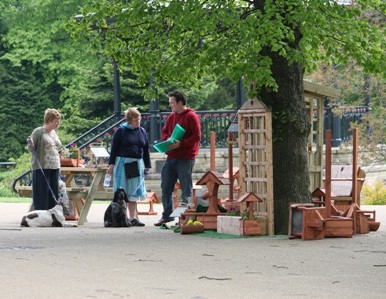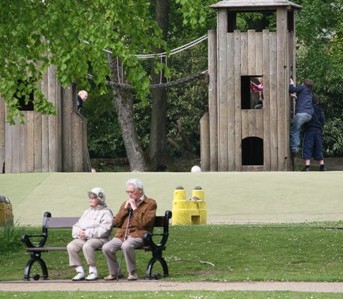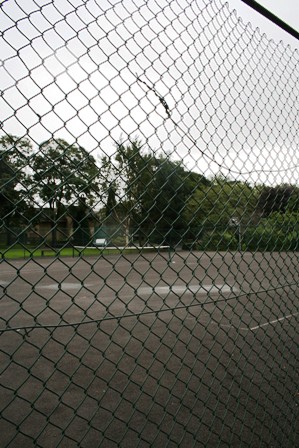Kay Adkins, hot tub correspondent
Edition number 10; dateline 3 September 2008
Parks: cue for a song in our collective heart
Picture this: I am driving along in a town close to home singing along to Parklife (Remember Brit Pop? Remember Blur?) and in a coincidental sort of way I find myself passing a local park. But the park doesn’t fit the lyrics ‘All the people, so many people’; in fact it’s very quiet and perhaps a little sad.
How different to my experience only the week before when I was at Crystal Palace for four days. I wasn’t there just to spend time in the park (consultants don’t have holidays) but as I was there, I took some time to run around it. However, if we go back to the song, it tells us ‘And it's not about you joggers who go round and round and round’ so I will take Blur’s advice and take you on a different journey.
The park, which is now known as Crystal Place, was created in 1852 on the side of Sydenham Hill. The creators raised £500,000 (equivalent to £25 million today) to create a two-hundred-acre park to be the home of the actual Crystal Palace, which was to be relocated from Hyde Park where it had been a central part of the Great Exhibition. When it was moved not only was the Crystal Palace rebuilt bigger and better but a variety of lakes, water temples and fountains were added. There was also a great maze, an English landscape garden and an Italian garden. In the end the project cost £1.3 million, which was £800,000 over budget (£50.5 million and £40 million in today’s money), and the facilities never came out of debt during the 82 years of its existence under the ownership and guidance of the Crystal Palace Trustees. Any lessons there for the ODA, do you think?
In 1960 the park became the home of one of our national sports centres. It cost £2.75 million and is now a Grade 2 listed building. Before that it had a football stadium, which was the venue for the FA Cup finals between 1885 and 1914, and was also the home of the studios and workshops of John Logie Baird, the early pioneer of television. In fact, what we see with a very brief look at its history is that the park has been a vital part of the local community, key to the social life of Londoners and a place of national importance to this very day; the London Grand Prix had taken place just before my visit.
Which brings me back to where I began, my ponderings on the importance of parks. The park at Crystal Palace, or I guess more accurately Sydenham Hill, is quite obviously a very important place in the community. Ignoring Blur’s comment that it isn’t about us joggers, let me take you for a quick run round it.
I left the London Leisure College and went through the gates opposite into the lower part of the park. Within a few feet I was running through a group of relaxed teenagers ‘hanging out’ under the walk-way at tables which I assume were there for that very purpose. Turning right, I headed into the Dinosaur Area which had parents with young children both looking at the dinosaurs and feeding the ducks which rule the lovely lakes. Heading out of this area, I passed the café which had many people looking much cooler than me as they ate their ice creams. Many of these people were obviously on their way home from work and taking a stop off as they walked from the Crystal Palace station to their homes. I then headed off (and up!) into a large open area in which people walked their dogs or just took the air; old and young walking and talking, people lying on the grass or having a picnic. As I headed further up the park I met other runners coming down and I skirted around the maze and up towards the television aerial which overlooks the terraces. On the terraces, yet more dog walkers but also people meditating, looking out over a rather impressive vista of South London. I also noticed that these terraces were soon to be the venue for a Caribbean bands competition and as if to illustrate this I received cheery hellos from two large Caribbean ladies who were out for a power walk and I suspect a good old gossip. As I gasped my way to the very top of the park (well it was 30 degrees and it is steep) I met people taking a quiet few minutes in an Italian garden area at the side of a bus station. At last I headed down towards the national sports centre itself and came across families heading off for swimming lessons as well as cyclists making their way through the area on their commute.
This park is obviously the communal back garden of many people. It is a central place where neighbours come to meet and chat; a place where people exercise, relax, enjoy open space, attend formal sports and arts events (there is an open air theatre in the grounds), walk through on their way to and from work and even learn new skills. This phenomenon is seen in all of the London parks I have frequented, which not only includes the biggies like Hyde Park and Regent’s Park but also those out in the East End such as Central Park in East Ham and West Ham Park. They are vital places for the community which I can say from very recent experience are a joy to be in. They are places where you DO see people communicating with each other as well as playing together – not something we are led to believe happens in our big cities, particularly London. Although I am careful not to be in the parks too late at night, I have found these spaces relaxing, safe, happy, in some cases beautiful, active places which are well worth the expenditure which is spent upon them.
After ‘bigging up’ the London’s parks I return to my local patch and I am afraid I can’t be quite as positive. Although it’s many years ago now, I once shared an office with senior officers from a local authority parks department and it was devastating to see these very proud people oversee what was very definitely the demise of their local parks and gardens. The council cut budgets, the nurseries which provided the beautiful plants were sold off and the up-keep of the parks was outsourced to private companies who, even if they did have the required enthusiasm, didn’t have the knowledge, skills or experienced staff. The usage of the parks dropped and even now they can be quite threatening places to be as they are the hang-out of teenage gangs. The quality of the formal pitches has dropped and the formal gardens have all but been lost as they cost too much to maintain. I paint quite a bleak picture although I am sure there are a range of parks across the country that fit somewhere between the vibrant parks of London and the sad little park in the local town that originally got me to thinking about all this.
As you can probably tell, I am a fan of parks but I think we need to be realists and ask ourselves about the role of parks in different areas. Where I live, we don’t need a formal park because we have wonderful trails and footpaths, we have spaces for playing pitches, we talk to each other in the street and we tend to have gardens in which we can relax. Our whole community could be placed in one of the larger London parks and contains many of things they have – apart from a 50m swimming pool! But for others, the park is vital to their well-being and should be defended to the end as they are vital to our health and happiness.
I will sum up by returning to Blur:
‘It gives me a sense of enormous well-being (parklife)
And then I'm happy for the rest of the day, safe in the knowledge
There will always be a bit of my heart devoted to it (parklife).’
So whether you are arty, sporty, a play person or steeped in heritage, let’s all continue to support our parks colleagues; they provide the places where we all do our thing.
Kay Adkins is an executive board member of a county sport partnership, chair of a CSN and a member of the interim board of the National Skills Academy for Sport and Active Leisure. Kay is also managing director of KAM Ltd, which offers a range of support services in the sport and leisure industry working in volunteer/workforce development and facility development.
Tales from a tub
the last word in contemplative comment on the leisure industry
Kay Adkins, hot tub correspondent

Parks in action

Action in parks

Parks' inaction